Citron Buddha Hand
Citron Buddha's Hand (Citrus medica var. Sarcodactylis) in botanical references is also known as "Citron finger". But in the English-speaking environment, citrus growers have long called it as it appears in the name. This bright, not quite ordinary folk nickname has spread all over the world, took root, and now even serious publications sometimes call the variety - Citrus medica "Buddha's Hand".
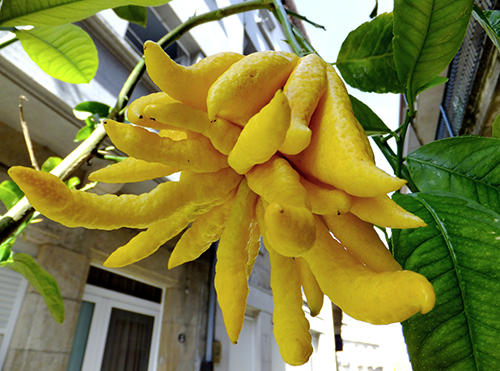
There is no doubt that the most important feature of our hero is his fruits, or rather, their form. She is unique in the citrus world! Even the name, which is also unusual, originated from these strange fruits. The fact is that their appearance clearly looks like a half-open human hand, or a squid with short, plump tentacles slightly apart.
The mystery of origin
No one knows exactly when, where and how this citron variety originated. Research indicates that Southeast Asia should be considered its homeland. Perhaps the southern regions of India, Malaysia or Indonesia. The plant is widespread in China, but with a high degree of probability it got there much later, along with the penetration of Buddhism.
There is no doubt that the amazing form of the fruit, which turned out to be a stable botanical trait, arose as a result of a gene mutation of "ordinary" citrons. Perhaps, the efforts of the ancient breeders of the East helped her to gain a foothold, with joy "supporting" the unusual appearance of the fruit. The image of a man who folded his palms in prayer ecstasy was associated with her. In India, the tree has long been considered sacred, it is widely used (still used) in religious ceremonies.

Botanical description
The Buddha's Hand has spread among lovers of homemade citrus fruits due to its unusual appearance. Culture has no serious industrial significance. In their homeland, trees are also used mainly for decorative purposes, although they also have practical applications.
Crown characteristic
In open field conditions, citron Buddha's Hand looks like a small plant about 3.5 meters high (sometimes it is slightly higher). In a pot culture, especially if the tree is indoors all year round, it rarely grows more than 1.5 meters. This compactness is a big advantage for indoor keeping.
Branches are long, tending to grow vertically, covered with sparse, small thorns. The leaves are beautiful, leathery, light green in color, growing on short, strong petioles. Their shape can be different, but always obviously oblong, with rounded ends. The average leaf length is approximately 9 - 14 cm, the width is half that.
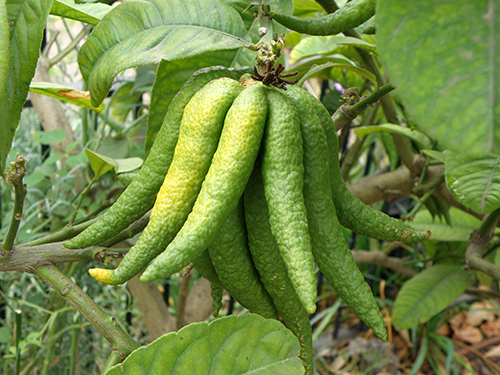
With good care, the tree develops quickly, reproduces well by rooting cuttings. Like all citrons, this one is also thermophilic, even in the winter months it is advisable not to drop the temperature below +5 ° C.
Interesting! Now breeders have bred the variegated form of this variety, on the leaf plate of which large creamy stains are visible.
Flowering features
The flowers are large, about 5 cm in diameter, located mostly singly. They have a strong pleasant scent. Now there are varieties in which buds and petals have a noticeable anthocyanin coloration, but the "original" Buddhas are distinguished by white flowers.
The peak of flowering occurs in the second half of spring, although some flowers can appear in the summer. Fruits ripen closer to winter.
Description of fruits
It has already been said about their unusual, even unique appearance. It should be added that the "fingers" on them do not always open. It has been noticed that this happens only in 10 - 20% of cases. The rest of the fruit resembles, rather, a slightly clenched fist.
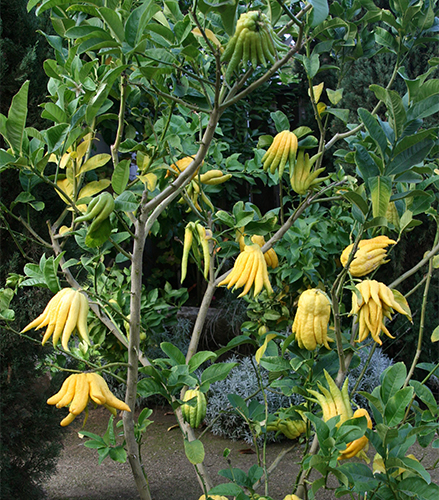
If the famous "rasping" has occurred, usually from 5 to 9 processes are observed. They can vary greatly in shape and size, resembling, in addition to human fingers, small bananas or squid tentacles. It is difficult to say why some fruits unfold and others do not. Surely, both conditions of detention and genetic characteristics play a role in this.
Like all citrons, this one also has a very thick rind, the volume of which can be up to half the size of the fruit itself. The surface of the peel is bumpy, the color is bright yellow. Its smell is remarkable: pleasant, extremely strong (it fills the whole room). The average weight is about 400 grams.
Separately, it should be said about the pulp and its taste:
- The volume of the pulp is small, it is dryish, has a cottony consistency.
- The taste is bitter or neutral; raw these fruits are not suitable for food.
- It contains a lot of essential oils and rare glycosides.
- The seeds are large, resembling pumpkin seeds, sometimes there can be quite a few of them. Their peculiarity is that they often begin to germinate already under the peel, if the fruit is overexposed on the tree.
Given this information, it becomes clear that these citrus fruits are not consumed directly in food. But they are used in cooking to get candied fruits, and also as a seasoning for various dishes. For this purpose, they are pre-dried or dried. Sometimes, however, the pulp is added to salads and raw. Also, the fruits are simply decorated with holiday dishes.
In addition, in the countries of the East, the citron Buddha's Hand is known as a cosmetic and medical product, it is widely used by Buddhists for their religious ceremonies.
Interesting! In the latter case, it is the closed fruits, in the form of a fist, that are valued. After all, a person in prayer folds his fingers, and does not spread them out! At the same time, among European flower growers, the wide-open form is considered a special achievement; it attracts with its uniqueness. These are the cultural differences in the human world that this tree opens!
Concluding the conversation about the "usefulness" of citron, we repeat that it is most often grown in the East as an ornamental plant that decorates the space around the house and inside it, filling the air with fragrance. As an industrial crop, it is of limited importance in Japan and China.

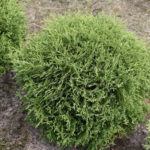



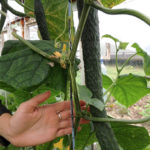



I would say that Buddha's Hand is a purely ornamental plant. And then - for lovers of exotic. I got a bush out of curiosity. In terms of content, it is quite unpretentious, but does not forgive all the same mistakes as other citruses - associated with watering, immediately "throws" the leaves. The flowering is similar to all citruses - insanely fragrant, friendly, but short-lived and dim. The fruits are basically all "closed", develop for more than six months. In the "green" state, they are practically invisible on the plant, in yellow, for some they look creepy and completely inedible. It grows poorly on the southern windows, does not like the direct bright sun. I tried to make candied fruits from the fruits - they did not come to taste. The plant is not for everyone, I did not leave it at home.